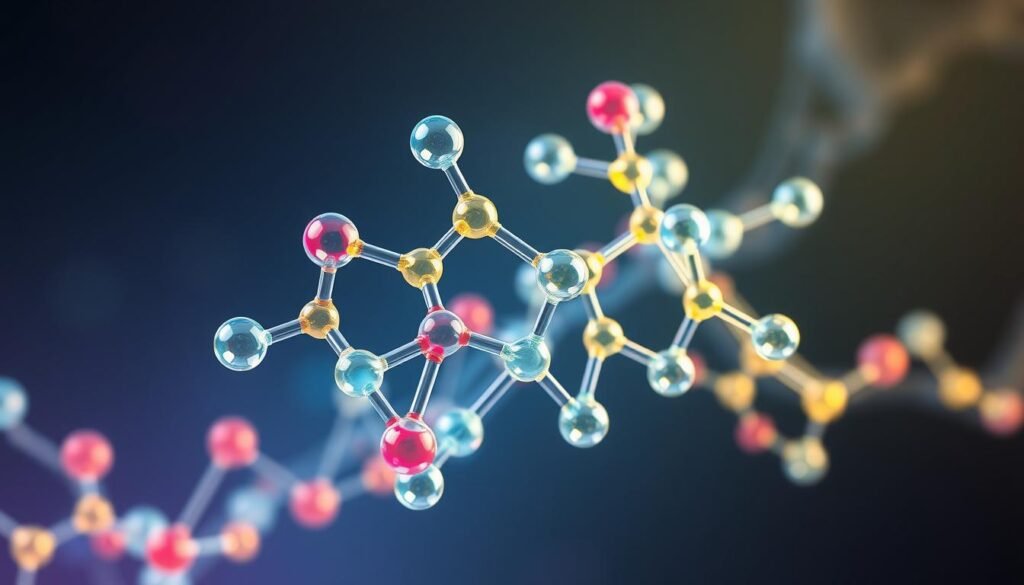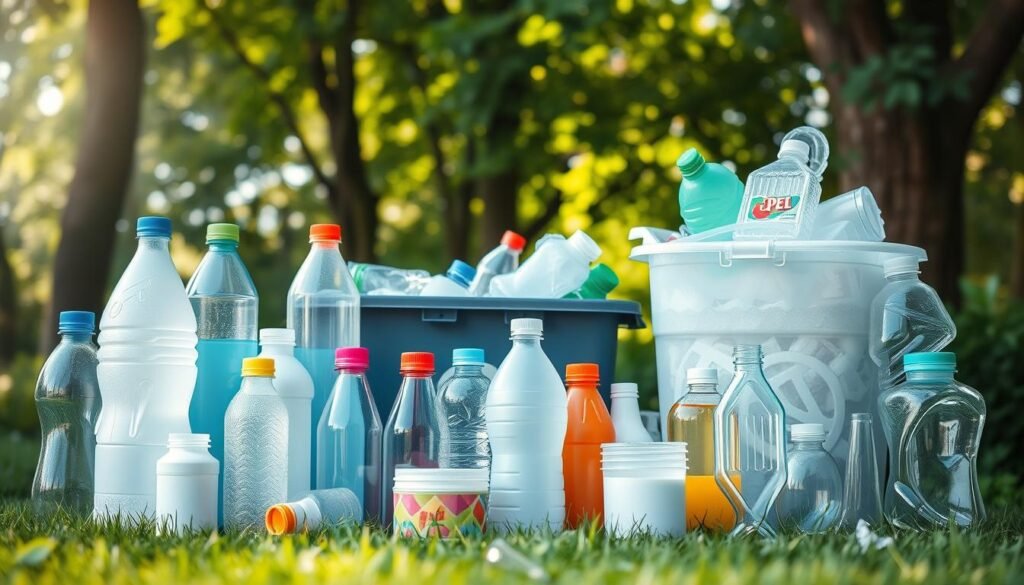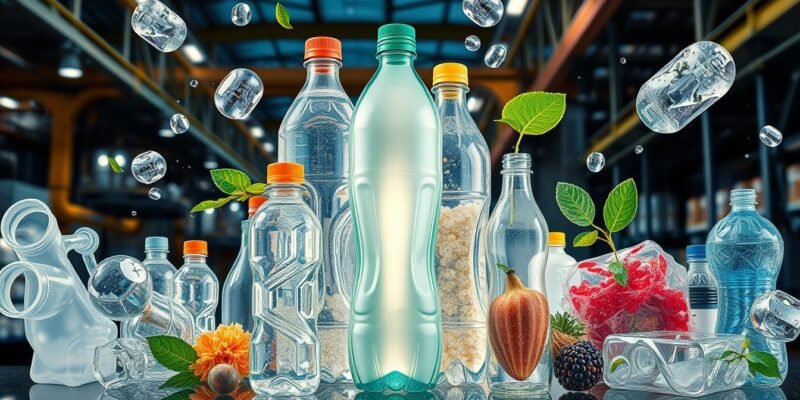Recognized as the most widely utilized thermoplastic polymer, Polyethylene terephthalate (PET) plastic exemplifies material innovation with applications that have evolved well beyond its original use. With its inception dating back to the 1940s, PET plastic continues to dominate industries, renowned for its clear, strong, and lightweight attributes. Its versatile thermoplastic nature and suitability for sustainable packaging solutions make it an irreplaceable component in modern manufacturing and product development.
We see the evidence of this versatility in the numbers, with a steady increase in PET recycling rates, as seen in Europe, where there was a collection of 1.923 million tonnes of PET bottles in 2017, a 2.9% increase from the previous year1. In line with this, PET’s role in sustainability is further validated, with the European Union setting ambitious targets for collecting and reprocessing 90% of all PET products by 2030 and incorporating at least 25% rPET in new bottles1. Such initiatives highlight PET plastic as a cornerstone of sustainable packaging efforts.
The sustainable profile of PET is enhanced by its production efficiency, with rPET reducing greenhouse emissions by 71% and using 79% less energy than virgin PET material, which drastically lowers the carbon footprint1. Moreover, PET’s high clarity and shatterproof quality not only make it a safe packaging option but also attractive for consumers, ensuring the product’s purity23. And as the leading plastic for beverage bottles, PET persists as a 100% recyclable material, supporting multiple recycling cycles and contributesto a circular economy23.
The polyethylene terephthalate applications are wide-ranging, from standard consumer packaging to technical textiles, demonstrating the enduring relevance of PET in today’s industries. We take pride in contributing to this progress by continuously seeking innovative approaches to refine PET plastic uses, enhancing both environmental responsibility and customer trust in our high-tech recycling machinery solutions.
The Prevalence and History of PET Plastic
Polyethylene terephthalate, commonly known as PET, has intricately woven itself into the fabric of modern society, a testament to its global adoption of PET and versatility. This lightweight yet sturdy polymer stands as a pillar in the polyester textiles industry and continues to innovate across various applications.
From Textiles to Bottles: The Evolution of PET Uses
The evolution of PET began in the mid-20th century, initially prized for its utility in polyester textiles. However, its potential expanded dramatically, reaching a crescendo as it reshaped the beverage industry. The origin of the iconic PET bottle traces back to its development and patenting in the early 1970s, which pivoted PET’s primary use from textiles to becoming a mainstay material for packaging solutions, reflecting a significant marker in PET history. The shift not only underscored the evolution of PET but also highlighted its adaptability and efficiency in mass production.
Chemists’ Ingenious Creation and its Global Adoption
Innovation spearheaded by visionary chemists transformed PET into a globally adopted material. The creation of PET bottles marked a revolutionary change, as they offered a safer, more economical alternative to glass and aluminum, prompting widespread acceptance across continents. This global adoption of PET was further fueled by its ability to be recycled, aligning with growing environmental sustainability concerns. Currently, PET packaging accounts for a substantial portion of single-serve beverage packaging, particularly evident in the US where it made up 44.7% in 20214.
However, as demand soared, the implications on waste management became apparent. Despite the high utility and recycling rates, a significant amount of PET still ends up in landfills. This reality posits a challenge and an opportunity to improve recycling rates and techniques globally.
Defining PET: A Basic Understanding
To fully appreciate PET’s role, one must understand its fundamental properties. PET is renowned for its strength, durability, and clarity, making it an ideal candidate for a myriad of applications beyond its initial textile usage. It features a high melting point and a specific density which ensures it remains stable under varied conditions. The compound annual growth rate of PET was projected to reach 21.93 metric tons between 2016 and 2021, reflecting its expansive growth5. PET’s journey from a textile fiber to a multifaceted essential in modern packaging underscores not only the evolution of PET but also a broader narrative of industrial adaptation and environmental considerations.
As we continue to navigate its applications and impact, understanding PET’s history and properties aids in leveraging its benefits while mitigating environmental impacts effectively. Our collective narrative with PET is still unfolding, and it holds key lessons and opportunities for future innovations in material science.
Examining the Properties of PET Plastic
At the forefront of modern material science, Polyethylene terephthalate (PET) offers an intriguing blend of characteristics that are highly valued across multiple industries. We delve into the defining properties and diverse applications of this pivotal material, highlighting its role as a recyclable material and its multifaceted polymer structure.
Inherent Qualities: Strength, Durability, and Transparency
PET is renowned for its robust strength-to-weight ratio, significant durability, and inherent transparency, making it an ideal choice for numerous demanding environments. Its capacity to resist impact and maintain clarity over time ensures that PET remains a popular material, particularly in packaging and bottling. Highly appreciated for its barrier properties against water vapor and gases, PET’s thermal properties allow it to withstand temperatures ranging from 70°C to its melting point around 250-260°C6. These characteristics not only preserve product integrity but also extend shelf life.
Polymer Structure and Variances in Material Grades
The polymer structure of PET significantly contributes to its mechanical properties. It can be modified into various material gradations, each tailored to specific applications. For instance, plastic bottles and food containers extensively use PET due to its rigidity and safe contact with consumables. The molecular weight of PET, around 192.17 g/mol, and its density of 1.3 g/cm³ allow it to be engineered into high-strength formats that are easily processable by most thermoplastic techniques6.
| PET Property | Description |
|---|---|
| Molecular Weight | Approximately 192.17 g/mol6 |
| Density | 1.3 g/cm³6 |
| Melting Point | 250–260 °C (482–500 °F)6 |
| Applications | Packaging (bottles, trays), Textiles (polyester fibers), Engineering Plastics6 |
| Recyclability | Highly recyclable with properties restored to near-virgin levels in processes6 |
To further illustrate, the variety of PET used impacts its application: PETG is acknowledged for its impact-resistance and suitability in demanding packaging environments, while rPET, derived from recycled PET, plays a critical role in sustainability initiatives by minimizing waste and resource consumption6.

In summary, the properties of PET such as PET properties, material gradations, and their thermal properties align seamlessly with the needs of both the textile and packaging industries, wherein PET’s utility is maximized due to its versatile polymer structure and recyclable nature7. These factors not only contribute to PET being the most recycled plastic globally but also ensure its position at the forefront of sustainable material solutions7.
Wide-Ranging Applications of PET Plastic in Industry
PET plastic, recognized for its durability and versatility, finds extensive use in various industrial segments. Among its notable applications are packaging materials, engineering plastics, and textile fibers. In the realm of PET industrial applications, PET has emerged as a material of choice due to its favorable mechanical properties and adaptability to different manufacturing processes like injection molding and 3D printing with PET filaments6.
In the automotive sector, PET contributes significantly to both performance and safety. Its application ranges from under-hood mechanical parts to interior components like seat belts and carpets. This wide usage benefits from PET’s excellent electrical insulating properties and resistance to environmental factors, making it suitable for the automotive industry PET uses. Notably, PET enhances vehicle safety standards and contributes to the advancement of modern automotive designs6.
The polyester textiles fashioned from PET fibers underline the material’s role in the apparel and home furnishing sectors. These textiles offer high durability, stain resistance, and are easy to care for, making them ideal for everyday use in various settings, from fashion to industrial applications. It’s estimated that PET constitutes more than half of the world’s synthetic fibers, underscoring its dominance in the textile industry7.
Moreover, the standards set by the FDA for PET use in food and beverage packaging reflect its safety and utility. These regulatory approvals, coupled with PET’s customization options—ranging from bottles of different sizes and shapes to those tailored for specific labeling needs—epitomize the balance between practicality and innovative packaging solutions provided by PET8.
On a broader scale, PET’s integration into daily and industrial products is continually evolving. It stands at the forefront of the sustainability movement, thanks to its high recyclability. Facilities across North America and Europe actively process PET to near-virgin quality, allowing it to cycle back into production without significant loss of performance or aesthetics. This process not only conserves resources but also reduces PET’s footprint on the environment7.
The vast range of PET industrial applications coupled with its inherent property of customization and recycling advocates for its extensive use. PET remains pivotal in driving innovations across various industries, from stride in the automotive industry PET uses to advancements in polyester textiles, leading towards a more sustainable and efficient future.
Addressing Misconceptions About PET Plastic
In our ongoing efforts to enhance understanding and clarify misconceptions, we delve into the real impacts of PET recycling and its perceived health and environmental issues. Despite being a leader among recycled materials, PET plastic is often surrounded by myths regarding its safety and efficacy in protecting our planet.
The Reality of PET Plastic’s Impact on Health and the Environment
Concerns about the safety of PET plastic often focus on the use of antimony oxide during production. However, it’s critical to recognize that the migration levels of antimony into consumables are significantly below the safety thresholds set by global health authorities9. Regulatory bodies like the FDA and the European Food Safety Authority have conducted extensive assessments and confirmed the health safety PET for food and beverage contact, underscoring its position as a secure packaging option in the industrial sector.

Addressing the environmental impact of PET plastic, it’s important to understand that while plastic waste is a concern, PET’s properties allow for substantial recycling benefits. Studies show that the weight of plastic packaging has been reduced by 25% since 1991 in Western Europe, leading to an annual reduction of almost 6.2 million tonnes of plastic9. Furthermore, advancements in recycling technology have made PET one of the most recycled packaging materials globally, laying the groundwork for a decrease in new plastic production and lower carbon emissions9.
Recycling PET: Facts Versus Fiction
Among the many plastic waste misconceptions is the belief that PET recycling is ineffective. However, the reality is quite the contrary. PET recycling processes have been refined over the years, significantly enhancing the environmental benefits of this practice. For instance, the rise of rPET (recycled PET) comes with a reduction in energy consumption and greenhouse gas emissions, compared to producing virgin PET9.
| Consumer Perception | Impact on Purchasing Decisions |
|---|---|
| Recycling instructions presence | 84% seek this info on packaging10 |
| Sustainability logos influence | 60% influenced significantly10 |
| Willing to pay more for sustainable packaging | 74% are willing in major markets10 |
The data underscores a growing consumer demand for sustainable practices in packaging, highlighting the importance of not only continuing but expanding PET recycling efforts. The transition towards more sustainable practices is not merely a trend but a necessary shift in the industry, driven by consumer awareness and regulatory pressure10.
PET’s Role in Sustainability and Recycling Initiatives
The utilization of PET plastic in sustainable practices and recycling initiatives is increasingly significant in advancing environmental health. Through modernized recycling processes and its contribution to circular economic models, PET, notably when transformed into rPET, stands as a paragon of green plastic innovation.
Innovative Recycling Techniques for PET
As we explore the realm of PET recycling, we are driven by a commitment to enhance PET sustainability through cutting-edge technologies. The recycling of PET involves complex processes where used bottles are collected, thoroughly cleaned, and then converted into high-quality plastic pellets, ready for a new life11. These recycled PET (rPET) pellets are not only utilized for crafting new bottles but also serve broader applications such as packaging and textiles, significantly lowering the industry’s reliance on virgin materials and reducing greenhouse gas emissions11.
Moreover, the recycling efficiency is capped by economic and logistical challenges. Contaminants mixed with PET batches can degrade the quality of recycled materials, thereby requiring sophisticated sorting techniques to maintain the purity and usability of processed rPET12. Nevertheless, advancements in sorting and processing technology continuously improve the yield and quality of recycled PET, making it a viable and green solution12.
Contribution to a Circular Economy: The rPET Phenomenon
The move toward a circular economy is exemplified by the increased incorporation of rPET in consumer products. This practice not only conserves natural resources but also aligns with the growing consumer preference for sustainable products. Employing rPET contributes significantly to environmental protection by reducing the need for virgin plastic production, thus conserving energy and reducing associated greenhouse gas outputs11.
In the U.S., states like New Jersey and California are pioneering the adoption of standards that mandate specific percentages of recycled content in PET bottles, leading a bold stride towards rPET innovation13. These legislative actions fortify the market for recycled plastics, paving the way for a robust, rejuvenated circular economy13.
The adoption of these initiatives illustrates a pivotal shift towards sustainable plastic use, depicting PET’s vital role in driving PET sustainability and emphasizing the importance of closed-loop recycling systems in achieving a green future.
This focused push towards integrating rPET extensively demonstrates the potential and indispensability of PET in fostering an environment-friendly industrial landscape.
Conclusion
As we reflect on the technological advancements and material innovation that PET plastic represents, it is undeniable that its significance stretches far beyond packaging convenience. PET plastic’s FDA-approved status for food and beverage packaging14 affirms its safety and evidences the regulatory trust in its use15. The material’s durability and versatility make it a staple in the food and beverage industry14, while its strength, low production cost, and lightweight nature have rendered it one of the top materials for plastic bottles15.
Environmental stewardship is at the forefront of PET plastic utilization, with its recyclability a key attribute; indeed, it is one of the most commonly recycled plastics14. Businesses like Sailor Plastic Bottles maximize this potential by offering customizable solutions and swift turnaround times for stock PET bottles14. The energy-efficient manufacturing of PET conserves water and fossil fuels, underscoring a commitment to sustainable practices15. Its capability to replace glass and metal due to energy consumption efficacy, coupled with a 100% recyclability rate, makes it a beacon in the fight to reduce waste and prevent environmental degradation15.
Looking forward, the trajectory for PET plastic is clear: to remain a favored choice within industries that value reliability and environmental responsibility. With over 30 years of endorsement from regulatory bodies worldwide15 and constant evolution towards greater sustainability, PET plastic’s story is far from over. It will continue to exemplify how material innovation can coincide with environmental stewardship, steering us toward a greener, more circular economy. Our collective journey with PET plastic is marked by an unwavering focus on efficiency, customer safety, and the promise of a sustainable future.
FAQ
What are the main uses of PET plastic in various industries?
PET plastic uses span a multitude of sectors due to its versatility as a thermoplastic. It is utilized extensively in sustainable packaging solutions, electrical and automotive parts, medical devices, and as polyester textiles in the fashion industry.
How has PET plastic evolved since its creation?
The evolution of PET began in the 1940s with its initial use in textiles. It progressed over the years to become a staple in packaging, with the development of the PET bottle in the 1970s, transforming it into a widely used material for consumer products.
What are the distinctive qualities of PET plastic that make it highly desirable?
PET plastic is known for its innate qualities such as high strength-to-weight ratio, durability, and transparency. These attributes, along with its recyclable nature, contribute to its demand across various applications.
What variations exist within PET polymer structure, and how do they affect its properties?
The polymer structure of PET can be modified in material grades to suit specific uses. These gradations adjust its mechanical and thermal properties, impacting its clarity, resistance to stress, and insulation capabilities.
In what way does PET plastic align with sustainability and recycling efforts?
PET plastic’s role in sustainability is evident through its high recyclability, which supports a circular economy. Efforts to create innovative recycling techniques have resulted in rPET, recycled PET, reducing raw material use and promoting environmentally-friendly practices.
Are there health risks associated with the use of PET plastic in food and beverage packaging?
The health safety of PET plastic in food and beverage contact has been verified by regulatory bodies such as the FDA and the European Food Safety Authority. Concerns about substances like antimony oxide have been dispelled due to minimal migration levels that are well below established safety thresholds.
Can PET plastic contribute to reducing plastic waste and environmental impact?
Yes, PET is one of the most recycled plastics, and its ability to be repurposed into new forms, such as in the creation of rPET, contributes significantly to reducing plastic waste and minimizing environmental impact.
How does the automotive industry employ PET plastics?
The automotive industry exploits PET plastic’s mechanical strength, UV resistance, and abrasion resistance by employing it in a variety of components such as seat belts, carpets, and interior paneling for enhanced safety and comfort.
What is the significance of PET plastic in today’s material landscape?
PET plastic holds a significant place due to its functionality, adaptability, and potential for recycling. It demonstrates a commitment to environmental stewardship while continually being integral to consumer goods development and manufacturing efficiency.
